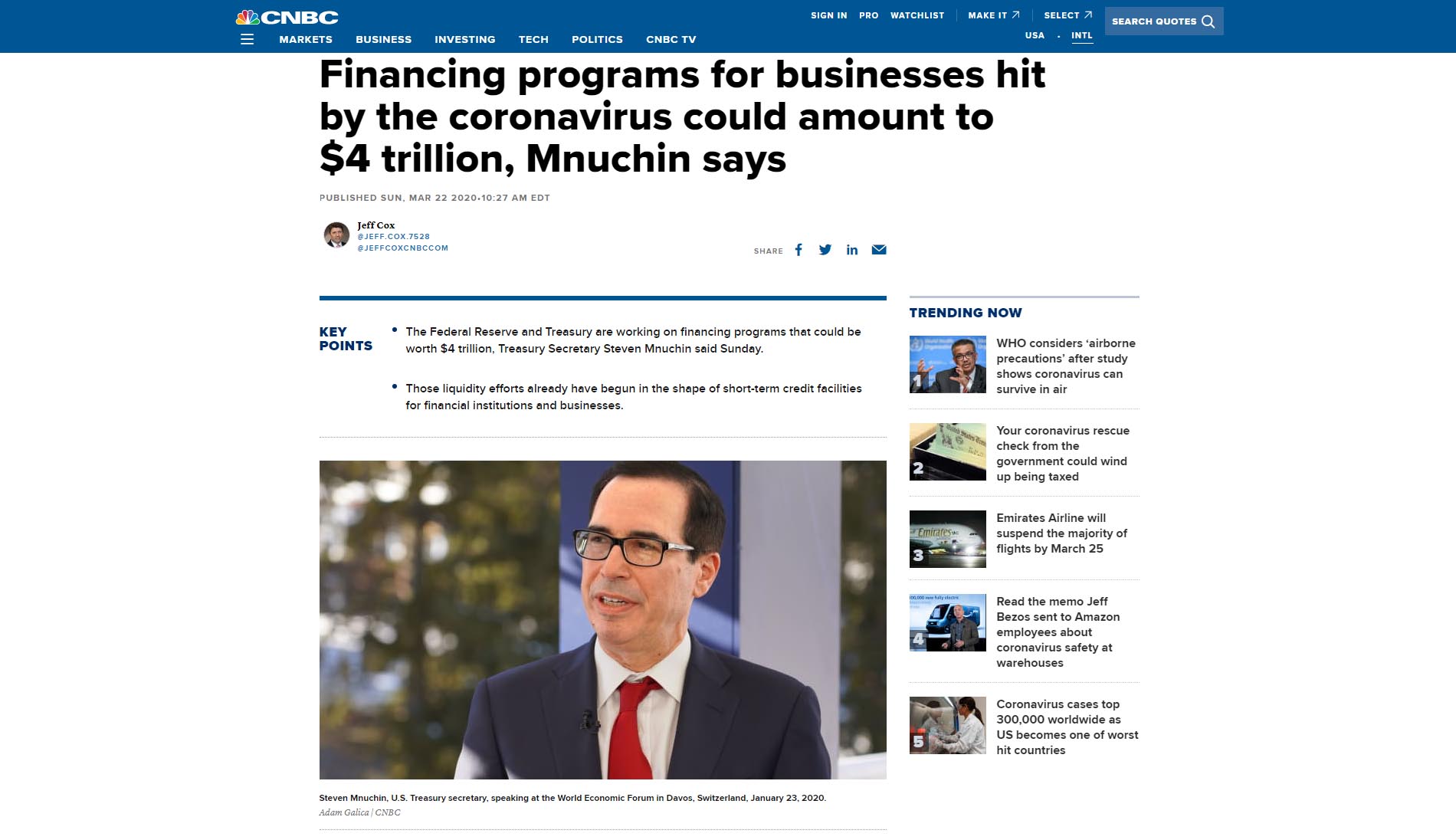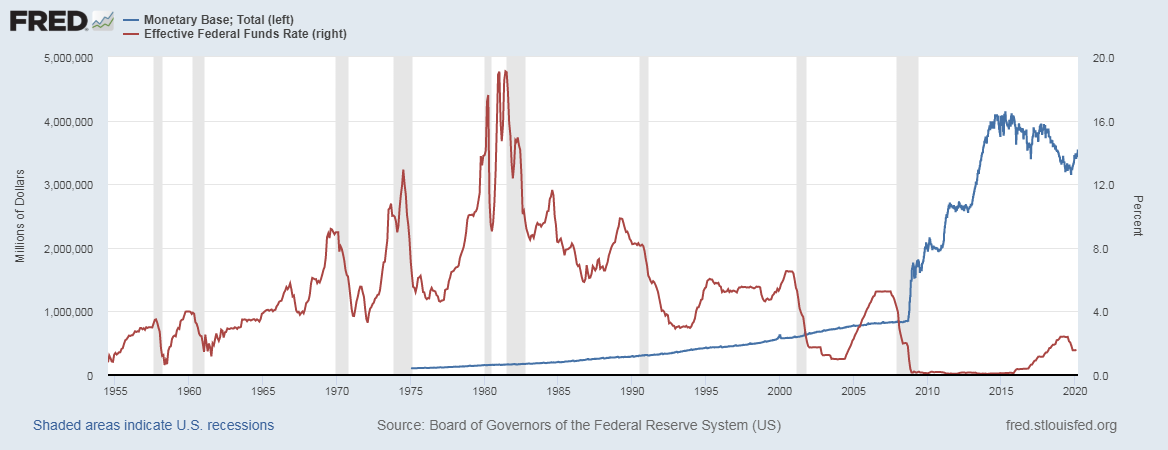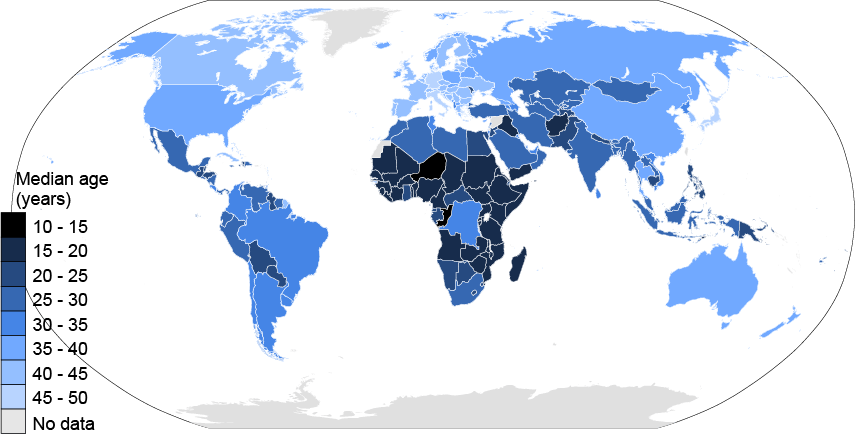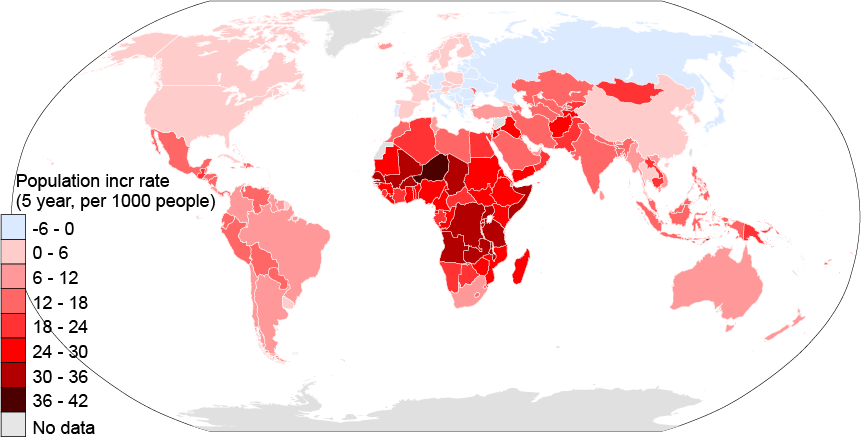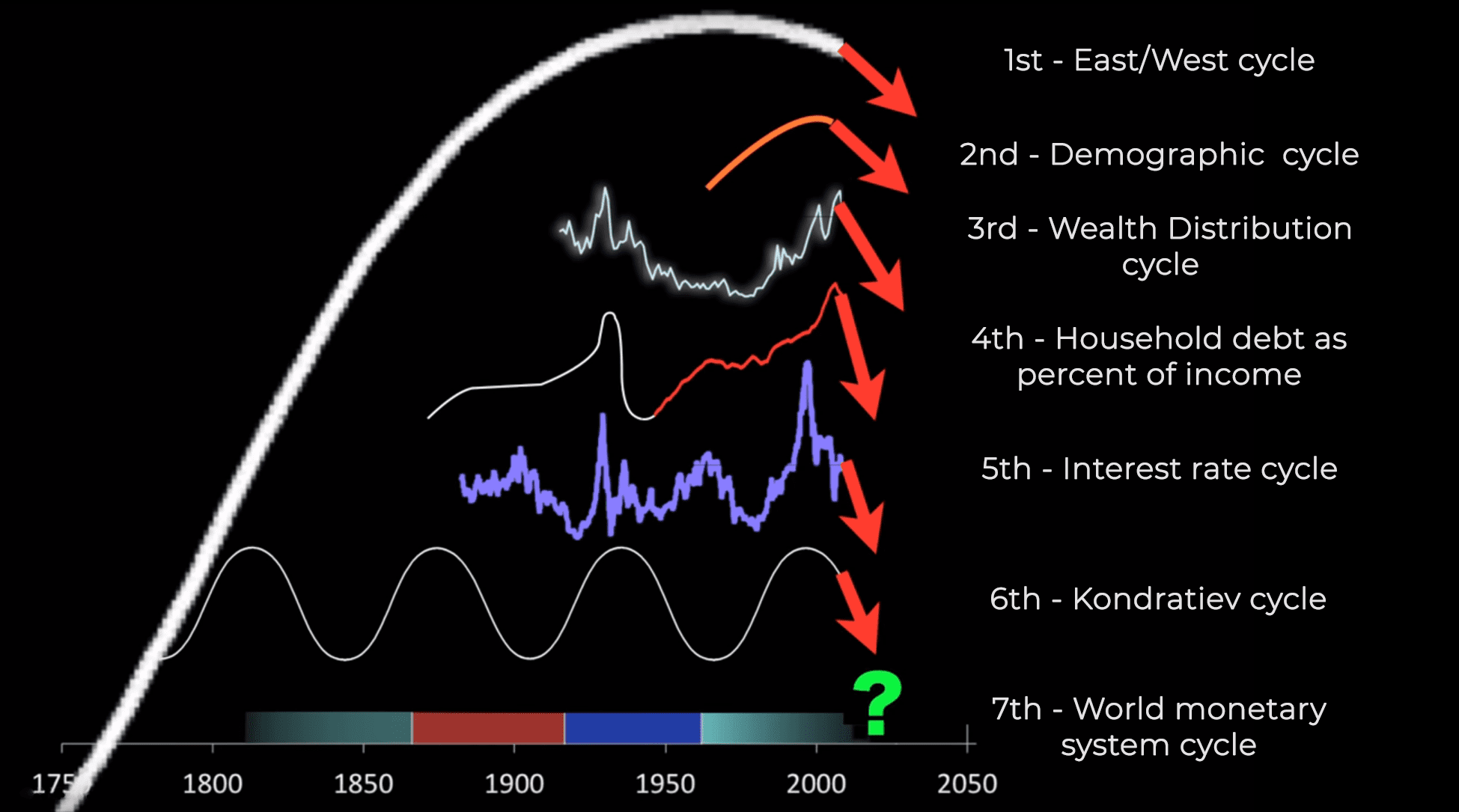The outbreak of COVID-19 pushes the whole globe deeper into deflation and trillions will be printed to fight it. Learn what is deflation, how bad is it and how to get rid of it. Moreover, 4 reasons are given that prove that we are already in deflation for more than 10 years in western economies
What is Deflation? How bad is it?
Deflation is a decline in prices of almost everything – resources, food and services. It is opposite to inflation where the prices of everything constantly increase. Very mild inflation (up to 2%) is not bad for the economy and we lived in it for the last 12 years.
During deflation, everything becomes cheaper (including real-estate, gold, silver, stocks) and cash increase in value, because with the same amount of cash you can buy more over time.
While you might think that deflation is good because cash increase in value and you can get more, in reality, it is very bad.
Over-time, because of the decreased turnover of businesses, companies must decrease salaries and then employers earn less.
When they earn less, they spend less, thus the prices of goods and services decrease even further.
During Deflation
- Unemployment rate rises
- Salaries decrease
- Businesses go bankrupt
- Young people can't find job
- Asset prices fall (real-estate, stocks)
- Governments run deficit spending
And the cycle continues. It is extremely problematic for individuals or companies who have debt. Basically, every individual and company has more or less debt.
During deflation, the turnover of companies and salaries of the employers decrease but the credit payments stay the same. Each month it requires higher and higher percent from your salary to pay the credit.
With deflation usually comes recession in the economy. I am sure that the recession will be announced in the next months around the world. For a technical recession, GDP in two consecutive quarters must be negative.
Recession is the worst economic period because people must produce more than they consume and it is painful. All assets lose value. Wealth disappears extremely fast.
4 Reasons why we are already in Deflation
Usually, deflation starts because of reduced consumption or contraction in the money supply.
Currently, we have extremely reduced consumption around the world and central banks try to pump trillions into the system to prevent the economy from falling into deep deflation and at the same time into the recession.
Look at the title below. FED will pump $4 trillion into the system. This number has 12 zeros. Furthermore, this is not the final value… Other countries around the world do the same.
Deflation is basically good in the long-term. If everyone (both rich and poor) becomes poor at the same time, then the economic cycle can restart. But it is extremely painful when it happens.
Below I collected 4 main reasons that prove that currently (2020) we are in a deflation around the world, especially in the western world.
1. Reduced consumption
The first reason is reduced consumption because of quarantine. Most of the world is quarantined at the moment.
All shopping malls, restaurants, bars, and so on are closed. Moreover, millions of events were canceled. Entire industries, such as traveling or car rental, do not function anymore.
Thousands of businesses will go bankrupt and people will lose their jobs soon. This fast reduction in consumption is the main reason for short but extreme deflation in 2020.
2. Over-reaction to 2008 financial crisis
As an example of the following statements, I will take the US economy. However, other countries around the world followed the same pattern and only the amount of currency supply differs.
To save the economy from the collapse during the financial crisis of 2008, central banks around the world made billions of dollars (or euros, or yen) out of thin air and bailed out many investment-banks.
Moreover, central banks continued to create huge amounts of money even after the crisis. Money created by the central bank in the US is shown with a blue line in the graph below. Furthermore, at the same time, they reduced interest rates (red line) to almost 0% and kept them low for more than 5 years.
Wealth created out of thin air
Basically, central banks created wealth by creating more and more money instead of producing real goods and services. Because interest rates were low, central banks were able to create currency cheap. In fact, that blue line which represents money supply shows that the US, in about 7-8 years, multiplied their currency supply by 5 times.
5 times!
By the way, Switzerland multiplied it by 12 times in the same period of time. Yup, by 12 times.
Everyone was expecting that this currency creation will create inflation, but it didn’t. Not yet.
Countries around the world had to print money because the economy was already going to deflation after the 2008 financial crisis.
Some of the newly created currency is held at central banks as a reserve currency and slowly leaks into circulation over time.
Another part of the newly created currency was used to fight deflation that already started in 2008. As it was explained before, currency creation is the only method to avoid deflation when consumption decreases.
3. Demographics - society is getting older
Demographics is a science about population, based on various factors, like age. You might think that demographics have no connection here, but believe me, it has a huge influence.
Because of various surveys and science of demographics, it is possible, for example, to see that people spend the most when they are 45-55 years old.
For example, people 55-65 years old start to save a lot because they understand that they will have to retire soon. They save every penny and do not consume much.
When individuals reach around 65 years old, they start to consume less and must be taken care of by social securities. They require most of the care and do not help the economy.
Furthermore, they sell almost everything (real estate, stocks, bonds, everything they have) and put deflationary pressure on the economy. Because of their selling, various assets slowly drop in price.
Demographical data
Nowadays, in most western countries exists a huge number of old people compared with young people that create products, services and pay taxes.
The world map below shows the average age of each countries population. Check the western world.
Furthermore, nowadays many young families marry very late and prefer to grow dogs instead of kids. This is crazy and pushes our western economies even further into deflation.
Check the world map below. According to current data, this deflationary pressure will only intensify in the coming years.
While demographics put strong deflationary pressure on the economy, this deflation caused by demographics happens quite slow compared with the deflation caused by the current reduction in consumption around the globe because of coronavirus.
4. Convergence of multiple economic cycles
Everything in the world works in cycles so does the economy as well. Regardless of anything, cycles repeat and repeat and are driven by human nature, fear, greed, and human psychology. Some cycles are shorter while others take hundreds of years.
7 cycles presented below prove, that we go into deflation. In fact, all 7 show coming deflation in the economy.
Look at the picture below. From the picture, it is clear that all cycles almost head down. Of course, they all will not turn downwards in a single day, but you see the general trend.
The downward trend of all these cycles is always deflationary for the economy.
I will not go into detail about all of these cycles. This picture is taken from the video series “Hidden Secrets of Money” created by Michael Maloney, where he explains these cycles in detail. I highly recommend you to watch this video.
1. East/West cycle
In short, 1st is East/West cycle which is the longest cycle that takes around 500 years to swing. It is the innovation and prosperity of society. It shows how the prosperity swings throughout the world, from Asia, through Europe to North America and back, over time.
I guess that most people already noticed that eastern countries started to grow and the East/West cycle turns already to east. This is also deflationary for the west because some investors will invest in eastern countries instead of western countries.
2. Demographic cycle
The demographic cycle shows that society in western economies is getting older. Older society is always deflationary as was explained earlier in the post.
3. Wealth distribution cycle
Wealth distribution varies over time and currently, a very small number of individuals in the world control more wealth than 90% of the rest. This is totally crazy!
Such a situation makes the population angry, socialism and populist ideas come to society. By the way, the middle class is doing very poorly these times.
Moreover, money printing always pushes asset prices higher, and most individuals from the middle class have no assets or investments at all.
While rich getting richer, middle and poor classes are getting poorer. History shows, that this won’t last long.
4. Household debt as percent of Disposable income cycle
Nowadays, individuals take more and more credit for various consumables. For example a mobile phone, TV or car. Over time, families take to much credit and later it becomes hard to sustain it.
In some cases, households take credit with great credit conditions (at that time) to buy a house or a flat that is extremely expensive (overpriced). Later, in the middle of the business cycle, interest rates increase and people do not have money to make credit payments. This is basically exactly what helped the 2008 financial crisis in the US to happen.
An increase in the debt of households is extremely deflationary because families spend to less to serve credit payments.
5. S&P 500 P/E Ratio cycle
Price / Earning is the measure of the share price relative to the annual net income earned by the firm per share. With each financial crisis, the stock market is going down and visits extremely lows.
It means that the P/E Ratio drops significantly to extreme lows.
However, with the 2000 dot.com bubble, the P/E ratio didn’t drop to the lowest levels as it always did. It indicates, that the last 2008 financial crisis was not deep enough. We still require extreme recession or depression in order to restart our economy for the next healthy economic boom.
6. The Kondratiev cycle
Nikolai Kondratiev – Russian economist who was supposed to prove that capitalism does not work. However, he found that capitalism is the superior system and works very well, but it would always have boom and bust cycles.
He called these cycles with season names: spring, summer, autumn and winter. While spring, summer and autumn provide economic growth, winter is an economic slowdown and is always deflationary.
While originally the length of the cycle was around 50-60 years, these days it is stretched and is somewhere around 90 years (the lifetime of humans).
He found out, that capitalism will always have cycles and it is impossible to avoid them. The only way is to understand them and use them for your advance.
P.S. The last winter according to Kondratiev cycle, was The Great Depression of 1929.
7. World monetary system cycle
Around every 30-40 years, the monetary system is slightly adjusted or changed in the world. While I will not cover all the history in detail, but in the last century, we experienced multiple monetary systems.
The classical gold standard, the gold exchange standard, the Bretton-Woods-system and finally purely fiat – the US dollar standard.
Now some new monetary system should come. Usually, each system lasted for around 30-40 years, but we are already 50 years with our current fiat currencies system.
Many countries around the world abandon the current dollar standard and try to trade bypassing dollars. The main reason is, that nobody likes the country which can simply create money in order to buy something (just as the US does). Countries lose confidence in the US and the US dollar itself.
Reasons for deflation in short
Deflation in our economy is unavoidable. Everything points to it. From money printing, which started after the 2008 financial crisis, it is quite clear, that we already live in mild deflation.
Unfortunately, because of the COVID-19 in the world, people must stay quarantined at home. They do not consume many things they normally would.
This reduction in consumption will change the way how many businesses work around the world.
Proof of Deflation
- Strong decrease in consumption
- Overreaction to 2008 financial crisis
- Demographics - Society is getting older
- Convergence of multiple economic cycles
Do you know that deflation creates the best investment opportunities? Learn how to profit from current deflation in western economies in this post:
The economy in 2020. Deflation, Hyperinflation and How To Profit from the Current Economic Situation
